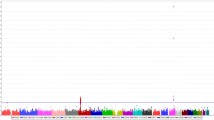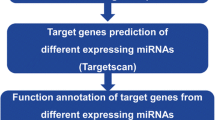Abstract
RegQTL, a novel concept, indicates that different genotypes of some SNPs have differential effects on the expression patterns of miRNAs and their target mRNAs. We aimed to identify the association between regQTL-SNPs and lung cancer risk and to explore the underlying mechanisms. The two-stage case–control study included the first stage in a Chinese population (626 lung cancer cases and 667 healthy controls) and the second stage in a European population (18,082 lung cancer cases and 13,780 healthy controls). Functional annotations were conducted based on the GTEx and the TCGA databases. Functional experiments were performed to explore the underlying biological mechanisms in vitro and vivo. After strict screening, five candidate regQTL-SNPs (rs7110737, rs273957, rs6593210, rs3768617, and rs6836432) were selected. Among them, the variant T allele of rs3768617 in LAMC1 was found to significantly increase the risk of lung cancer (first stage: P = 0.044; second stage: P = 0.007). The eQTL analysis showed that LAMC1 expression level was significantly higher in subjects with the variant T allele of rs3768617 (P = 1.10 × 10–14). In TCGA paired database, the regQTL annotation indicated the different expression patterns between LAMC1 and miRNA-548b-3p for the distinct genotypes of rs3768617. Additionally, LAMC1 knockdown significantly inhibited malignant phenotypes in lung cancer cell lines and suppressed tumor growth. A novel regQTL-SNP, rs3768617, might affect lung cancer risk by modulating the expression patterns of miRNA-548b-3p and LAMC1. RegQTL-SNPs could provide a new perspective for evaluating the regulatory function of SNPs in lung cancer development.






Similar content being viewed by others
Availability of data and material
The data that support the findings of this study are available from the corresponding author upon reasonable request.
References
Avino P, Scungio M, Stabile L, Cortellessa G, Buonanno G, Manigrasso M (2018) Second-hand aerosol from tobacco and electronic cigarettes: evaluation of the smoker emission rates and doses and lung cancer risk of passive smokers and vapers. Sci Total Environ 642:137–147. https://doi.org/10.1016/j.scitotenv.2018.06.059
Berania I, Cardin GB, Clement I et al (2017) Four PTEN-targeting co-expressed miRNAs and ACTN4- targeting miR-548b are independent prognostic biomarkers in human squamous cell carcinoma of the oral tongue. Int J Cancer 141(11):2318–2328. https://doi.org/10.1002/ijc.30915
Cao M, Chen W (2019) Epidemiology of lung cancer in China. Thorac Cancer 10(1):3–7. https://doi.org/10.1111/1759-7714.12916
Cen WN, Pang JS, Huang JC et al (2018) The expression and biological information analysis of miR-375-3p in head and neck squamous cell carcinoma based on 1825 samples from GEO, TCGA, and peer-reviewed publications. Pathol Res Pract 214(11):1835–1847. https://doi.org/10.1016/j.prp.2018.09.010
Chen K, Song F, Calin GA, Wei Q, Hao X, Zhang W (2008) Polymorphisms in microRNA targets: a gold mine for molecular epidemiology. Carcinogenesis 29(7):1306–1311. https://doi.org/10.1093/carcin/bgn116
Deb B, Uddin A, Chakraborty S (2018) miRNAs and ovarian cancer: an overview. J Cell Physiol 233(5):3846–3854. https://doi.org/10.1002/jcp.26095
Dolatabadi NF, Dehghani A, Shahand E et al (2020) The interaction between MALAT1 target, miR-143-3p, and RALGAPA2 is affected by functional SNP rs3827693 in breast cancer. Hum Cell 33(4):1229–1239. https://doi.org/10.1007/s13577-020-00422-x
Elgharably H, Okamoto T, Ayyat KS et al (2020) Human lungs airway epithelium upregulate microRNA-17 and microRNA-548b in response to cold ischemia and ex vivo reperfusion. Transplantation 104(9):1842–1852. https://doi.org/10.1097/TP.0000000000003370
Feng L, Wang R, Yang Y et al (2021) KPNA4 regulated by miR-548b-3p promotes the malignant phenotypes of papillary thyroid cancer. Life Sci 265:118743. https://doi.org/10.1016/j.lfs.2020.118743
Ferreiro-Iglesias A, Lesseur C, McKay J et al (2018) Fine mapping of MHC region in lung cancer highlights independent susceptibility loci by ethnicity. Nat Commun 9(1):3927. https://doi.org/10.1038/s41467-018-05890-2
GBD 2016 Disease and Injury Incidence and Prevalence Collaborators (2017) Global, regional, and national incidence, prevalence, and years lived with disability for 328 diseases and injuries for 195 countries, 1990–2016: a systematic analysis for the Global Burden of Disease Study 2016. Lancet 390(10100):1211–1259. https://doi.org/10.1016/S0140-6736(17)32154-2
Gong J, Mei S, Liu C et al (2018) PancanQTL: systematic identification of cis-eQTLs and trans-eQTLs in 33 cancer types. Nucleic Acids Res 46(D1):D971–D976. https://doi.org/10.1093/nar/gkx861
He R, Kong Y, Fang P, Li L, Shi H, Liu Z (2020) Integration of quantitative proteomics and metabolomics reveals tissue hypoxia mechanisms in an ischemic-hypoxic rat model. J Proteomics 228:103924. https://doi.org/10.1016/j.jprot.2020.103924
Jeon J, Holford TR, Levy DT et al (2018) Smoking and lung cancer mortality in the United States from 2015 to 2065: a comparative modeling approach. Ann Intern Med 169(10):684–693. https://doi.org/10.7326/M18-1250
Khan S, Greco D, Michailidou K et al (2014) MicroRNA related polymorphisms and breast cancer risk. PLoS ONE 9(11):e109973. https://doi.org/10.1371/journal.pone.0109973
Kulkarni S, Abdulla R, Jose M et al (2019) Omics data-driven analysis identifies laminin-integrin-mediated signaling pathway as a determinant for cell differentiation in oral squamous cell carcinoma. Indian J Pathol Microbiol 62(4):529–536. https://doi.org/10.4103/IJPM.IJPM_1_19
Liu J, Liu D, Yang Z, Yang Z (2019) High LAMC1 expression in glioma is associated with poor prognosis. Onco Targets Ther 12:4253–4260. https://doi.org/10.2147/OTT.S205333
Mucci LA, Hjelmborg JB, Harris JR et al (2016) Familial risk and heritability of cancer among twins in nordic countries. JAMA 315(1):68–76. https://doi.org/10.1001/jama.2015.17703
Mullany LE, Wolff RK, Herrick JS, Buas MF, Slattery ML (2015) SNP regulation of microRNA expression and subsequent colon cancer risk. PLoS ONE 10(12):e0143894. https://doi.org/10.1371/journal.pone.0143894
Namani A, Liu K, Wang S et al (2019) Genome-wide global identification of NRF2 binding sites in A549 non-small cell lung cancer cells by ChIP-Seq reveals NRF2 regulation of genes involved in focal adhesion pathways. Aging (albany NY) 11(24):12600–12623. https://doi.org/10.18632/aging.102590
Paul ABM, Sadek ST, Mahesan AM (2019) The role of microRNAs in human embryo implantation: a review. J Assist Reprod Genet 36(2):179–187. https://doi.org/10.1007/s10815-018-1326-y
Pierce JP, Shi Y, McMenamin SB et al (2019) Trends in lung cancer and cigarette smoking: California compared to the rest of the United States. Cancer Prev Res (phila) 12(1):3–12. https://doi.org/10.1158/1940-6207.CAPR-18-0341
Rao A, Arvinden VR, Ramasamy D et al (2021) Identification of novel dysregulated circular RNAs in early-stage breast cancer. J Cell Mol Med 25(8):3912–3921. https://doi.org/10.1111/jcmm.16324
Ryan BM (2017) MicroRNAs in cancer susceptibility. Adv Cancer Res 135:151–171. https://doi.org/10.1016/bs.acr.2017.06.004
Sha MX, Huang XW, Yin Q (2020a) MiR-548b-3p inhibits proliferation and migration of breast cancer cells by targeting MDM2. Eur Rev Med Pharmacol Sci 24(6):3105–3112. https://doi.org/10.26355/eurrev_202003_20675
Sha Z, Lai R, Zhang X et al (2020b) A polymorphism at the microRNA binding site in the 3’ untranslated region of KRT81 is associated with breast cancer. DNA Cell Biol 39(10):1886–1894. https://doi.org/10.1089/dna.2019.5179
Simon-Assmann P (2013) The laminin family: founding members of the basement membrane. Cell Adh Migr 7(1):44–47. https://doi.org/10.4161/cam.23276
Sung H, Ferlay J, Siegel RL et al (2021) Global cancer statistics 2020: GLOBOCAN estimates of incidence and mortality worldwide for 36 cancers in 185 countries. CA Cancer J Clin 71(3):209–249. https://doi.org/10.3322/caac.21660
Takashima Y, Kawaguchi A, Iwadate Y et al (2020) miR-101, miR-548b, miR-554, and miR-1202 are reliable prognosis predictors of the miRNAs associated with cancer immunity in primary central nervous system lymphoma. PLoS ONE 15(2):e0229577. https://doi.org/10.1371/journal.pone.0229577
Turner MC, Andersen ZJ, Baccarelli A et al (2020) Outdoor air pollution and cancer: an overview of the current evidence and public health recommendations. CA Cancer J Clin. https://doi.org/10.3322/caac.21632
Wang Y, Xia H, Zhuang Z, Miao L, Chen X, Cai H (2014) Axl-altered microRNAs regulate tumorigenicity and gefitinib resistance in lung cancer. Cell Death Dis 5:e1227. https://doi.org/10.1038/cddis.2014.186
Wang G, Bai Y, Fu W et al (2019) Daily cooking duration and its joint effects with genetic polymorphisms on lung cancer incidence: results from a Chinese prospective cohort study. Environ Res 179(Pt A):108747. https://doi.org/10.1016/j.envres.2019.108747
Wang Z, Wu X, Hou X et al (2020) miR-548b-3p functions as a tumor suppressor in lung cancer. Lasers Med Sci 35(4):833–839. https://doi.org/10.1007/s10103-019-02865-7
Wilk G, Braun R (2018) RegQTLs: single nucleotide polymorphisms that modulate microRNA regulation of gene expression in tumors. PLoS Genet 14(12):e1007837. https://doi.org/10.1371/journal.pgen.1007837
Wilkins OM, Titus AJ, Salas LA et al (2019) MicroRNA-related genetic variants associated with survival of head and neck squamous cell carcinoma. Cancer Epidemiol Biomark Prev 28(1):127–136. https://doi.org/10.1158/1055-9965.EPI-18-0002
Ye G, Qin Y, Wang S et al (2019) Lamc1 promotes the Warburg effect in hepatocellular carcinoma cells by regulating PKM2 expression through AKT pathway. Cancer Biol Ther 20(5):711–719. https://doi.org/10.1080/15384047.2018.1564558
Yu Y, Mao L, Lu X et al (2019) Functional variant in 3’UTR of FAM13A is potentially associated with susceptibility and survival of lung squamous carcinoma. DNA Cell Biol 38(11):1269–1277. https://doi.org/10.1089/dna.2019.4892
Zacapala-Gomez AE, Alarcón-Romero LDC, Mendoza-Catalan MA et al (2020) Integrin subunit beta1 and laminin gamma1 chain expression: a potential prognostic biomarker in cervical cancer. Biomark Med 14(15):1461–1471. https://doi.org/10.2217/bmm-2020-0140
Zhang Y, Xi S, Chen J et al (2017) Overexpression of LAMC1 predicts poor prognosis and enhances tumor cell invasion and migration in hepatocellular carcinoma. J Cancer 8(15):2992–3000. https://doi.org/10.7150/jca.21038
Zhou M, Wang H, Zeng X et al (2019) Mortality, morbidity, and risk factors in China and its provinces, 1990–2017: a systematic analysis for the Global Burden of Disease Study 2017. Lancet 394(10204):1145–1158. https://doi.org/10.1016/S0140-6736(19)30427-1
Acknowledgements
The authors are grateful for the help of Pro. Zuo-Feng Zhang from University of California Los Angeles and Dr. Rayjean Hung from the ILCCO who help in applying for European GWAS data. We also thank the patients and investigators who participated in TCGA and GTEx for providing the data.
Funding
This work was supported by the National Natural Science Foundation of China (81502876, 81703297), Natural Science Foundation of Jiangsu Province (BK20191449), The Jiangsu Association of Science and Technology Youth Science and Technology Talents Enrollment Project in 2019, Jiangsu Government Scholarship for Overseas Studies (JS-2019-256), Science and Technology Program of Nantong City (JC2019119), Postgraduate Research & Practice Innovation Program of Jiangsu Province (KYCX21-3126, KYCX20-2852, KYCX19-2082).
Author information
Authors and Affiliations
Contributions
YY, LM, ZC, XZ, and JC participated in functional experiments, collecting data, analyzing data, and drafting the article. XF, JC, YZ, AQ, and YD participated in data analyses. XZ, YL, and YL participated in revising the article. TT, SW, and MC contributed to the design and coordination of the study. All authors read and approved the final article. All the authors listed have approved the article and contributed significantly.
Corresponding authors
Ethics declarations
Conflict of interest
The authors declare that they have no conflict of interest.
Ethical approval
The study was reviewed and approved by the Ethics Committee of Nantong University (Approval No.: 2019-021). Written informed consent was obtained from all patients.
Additional information
Publisher's Note
Springer Nature remains neutral with regard to jurisdictional claims in published maps and institutional affiliations.
Supplementary Information
Below is the link to the electronic supplementary material.
Rights and permissions
About this article
Cite this article
Yu, Y., Mao, L., Cheng, Z. et al. A novel regQTL-SNP and the risk of lung cancer: a multi-dimensional study. Arch Toxicol 95, 3815–3827 (2021). https://doi.org/10.1007/s00204-021-03170-5
Received:
Accepted:
Published:
Issue Date:
DOI: https://doi.org/10.1007/s00204-021-03170-5




